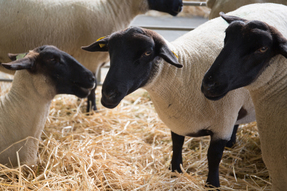 What is it?
A transmissible spongiform encephalopathy (affects the
brain) impacting sheep and goats. It’s found worldwide, except in Australia and
New Zealand. It’s related to bovine spongiform encephalopathy (mad cow disease)
and chronic wasting disease in deer and elk, and is part of a national
eradication program in the United States.
How is it
transmitted?
Scrapie is understood to be transmitted during lambing
and kidding, when the newborn lambs/kids or other sheep/goats in the flock have
contact with the placenta and/or birth fluids from infected ewes or does. It is
also believed previously infected premises can leave contaminants behind and
infect exposed sheep or goats.
What are the signs
in animals?
Infected animals may display neurologic and behavior
changes, such as lip smacking, nervousness, scratching or rubbing on objects,
hypersensitivity to noise or movement, bunny hopping, and lack of coordination.
Signs appear between two to five years after infection and once the clinical
signs appear, the animal typically dies within six months.
What is the
treatment?
Once scrapie is identified in a flock, treatment consists
of testing and depopulating to remove all infected animals from the farm. Those
animals are properly disposed to reduce further risk of spreading the disease.
How is scrapie in
animals diagnosed?
In sheep, a blood testing process called genotyping
allows veterinarians to determine if the sheep is susceptible or resistant to scrapie.
The role of genetics in goats remains unknown. Veterinarians diagnose scrapie
based on history, clinical signs, and tissue from the rectum of a live animal
or the brain of a dead animal.
Is there a risk to
people?
There is no evidence to support a threat to human health.
How can it be
prevented?
By tracking and reporting the disease to state and
federal animal health authorities. Tracking of this disease is vital to the
goal of eliminating it from the United States.
|